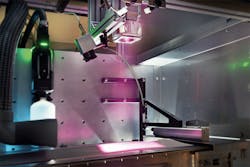Finding efficiencies and improving performance fuel Fraunhofer ILT research efforts
With a focus on tackling the known issues in the e-mobility battery production process, researchers at the Fraunhofer Institute for Laser Technology (Fraunhofer ILT; Aachen, Germany) recently developed two laser-based manufacturing technologies to save energy in production and create battery cells with higher power density and a longer service life.
One of the key steps in producing lithium-ion batteries (LIBs) is the manufacture of graphite-based electrodes. For these electrodes, a copper foil is coated with a graphite paste using roll-to-roll processes and then dried in inefficient and space-consuming continuous furnaces operating at 160°–180°C.
Finding efficiencies
Their system uses a diode laser to carry out the drying process (see figure). The laser beam has a wavelength of 1 µm and is amplified by special optics, created by Laserline, to illuminate the electrode over a large area. “Our diode laser projects a high-intensity beam onto the copper foil, which is coated with graphite paste. The jet-black graphite absorbs the energy. The resulting interaction causes the graphite particles to heat up and the liquid to evaporate,” says Samuel Fink, group leader for thin film processing at Fraunhofer ILT.
This approach has gained additional relevance due to the energy issues in Europe. “The laser sources that we use are of course driven electrically, whereas ‘normal’ convection ovens are often driven with natural gas,” says Fink, who predicts this approach will reduce the energy required by 50%. “That gives us the option to do the laser-based processing with renewable energy sources. We are especially looking forward to next year, as the laser drying process will be implemented in a production-scale facility at our project partners. Then, we will gain much insight into the potential of the technology.”
Improving performance
The Fraunhofer ILT team has also improved the power density and lifetime of the LIBs using laser technology. Specifically, a high-power ultrashort-pulse (USP) laser with 1 mJ of pulse energy introduces a hole structure, referred to as channels, into the battery electrode. The channels serve as a highway for the ions, significantly reducing the distance the ions must travel and shortening the charging process. By lessening the likelihood of defects, this process increases the number of charging cycles and ultimately extends the battery life.
Both the laser-based process for producing the hole structures and the positive impact they have on the battery cell are theoretically well-known. What the Fraunhofer researchers have done is to transfer the principles into praxis: from the laboratory to a scalable, industry-ready process that uses USP laser radiation in the femtosecond range to modify the electrodes. “The short interaction time of the laser pulses is sufficient to ablate the material, but also prevents the holes from melting, which means that the battery does not lose power,” says Matthias Trenn, team leader for surface structuring at Fraunhofer ILT.
Conquering challenges
One challenge the Fraunhofer ILT scientists faced was how to process larger areas to achieve the high throughput required for industrial production. The team solved this problem by using a multibeam arrangement with parallel process control. Four scanners, each with six beamlets, process the foil in parallel. They cover a width of 250 mm and process the graphite layer continuously. The multibeam optics were developed and implemented in close collaboration with Pulsar Photonics GmbH, a Fraunhofer ILT spinoff founded in 2013.
However, the biggest challenge at this point is also the primary focus going forward. “We are mainly focusing on the scale-up to bring the technology on the road, but also need to develop a better understanding of the processes themselves. Industrial-scale LIB production runs at coatings speed of 100 m/min or more. For the drying and structuring process, that means a significant energy input,” says Fink. “This energy input has to be tuned very cautiously and requires a deep understanding of the physical processes happening in the laser-based drying and structuring to avoid damaging the electrodes.”
About the Author
Peter Fretty
Market Leader, Digital Infrastructure
Peter Fretty began his role as the Market Leader, Digital Infrastructure in September 2024. He also serves as Group Editorial Director for Laser Focus World and Vision Systems Design, and previously served as Editor in Chief of Laser Focus World from October 2021 to June 2023. Prior to that, he was Technology Editor for IndustryWeek for two years.
As a highly experienced journalist, he has regularly covered advances in manufacturing, information technology, and software. He has written thousands of feature articles, cover stories, and white papers for an assortment of trade journals, business publications, and consumer magazines.

